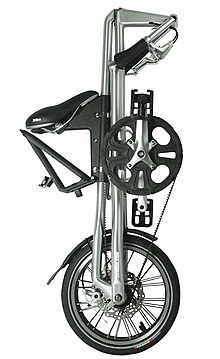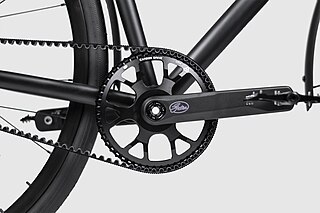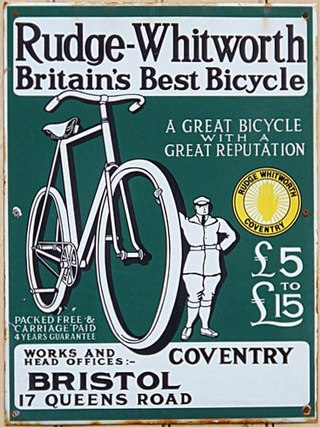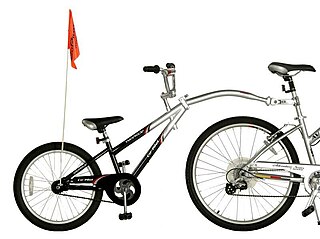



Strida is a portable belt-driven folding bicycle with a distinctive A-shaped collapsible frame, designed by British engineer and designer Mark Sanders. The first model, Strida 1, was released in 1987 and the latest, Strida 5.2, in 2009.




Strida is a portable belt-driven folding bicycle with a distinctive A-shaped collapsible frame, designed by British engineer and designer Mark Sanders. The first model, Strida 1, was released in 1987 and the latest, Strida 5.2, in 2009.
The Strida folds into a "wheeled walking-stick" that can be pushed along, much like a folded pram/baby-buggy whose folding concept provided the inspiration for the design.
Other notable characteristics include:
The single sided wheel mountings and belt drive make fitting gears (e.g. dérailleur or hub gears) more difficult than on chain driven bikes with conventional forks. The use of front mounted Schlumpf gear gets around this problem. Hobbyists in Japan have fitted 5 [1] [2] [3] and 7 [4] speed gears.
The Strida was the major project [5] for Mark Sanders's master's degree 1983 to 1985 at Imperial College London, and Royal College of Art. The course, IDE, (Industrial Design Engineering, now called Innovation Design Engineering [6] ) was a joint course by both institutions for engineering graduates to specialise in combining creative engineering with creative industrial design. The project is recorded in detail in the master's degree thesis. [7] The aim of the project was to simplify bicycles and especially folding bicycles. It was inspired by the Maclaren baby buggy which folds into a thin form, with its wheels together at the end, so that it can be rolled instead of being carried.
In 1985, Industrial Property Rights Ltd, (run by James Marshall, [8] former manager of golfer Greg Norman) licensed the design. [9] The name 'Strida' was suggested by the 8-year-old son of one of the company directors; this was adopted as it was preferred to the suggestion 'Blake' by a PR consultancy. Production of the Strida 1 started in 1986, originally in Springburn, Glasgow. The Strida was launched in Harrods, London in 1987. [10] Approximately 3,000 Strida 1s were made in Glasgow - these can be recognised by a welded steel rack, later replaced by a nylon injection moulded rack, which latter remains in production.
In 1988, production moved to Long Eaton in Nottingham (near the Raleigh Bicycle Company factory, which by then was in decline). Sturmey-Archer developed a 2-speed, front-mounted gear which was prototyped and tested but never made in production. The Strida won all three UK Cyclex Bicycle Innovation Awards in 1988 [11] (Best New Product, Most Innovative, Best British Design). Approximately 17,000 Strida 1s were made in Nottingham. [12] Most were sold in Japan and UK, with smaller quantities in USA, Australia and Germany.
In 1991, production moved to Casa Hipolito, a Portuguese Manufacturer. At this time Strida Ltd. was developing a baby buggy as a second product.
By 1992, 25,000 Strida 1s had been produced.
In 1993, the British Technology Group BTG, a company that licenses and commercializes medical innovations and other UK technology, controlled the rights to Strida until 1995.
In 1997, Roland Plastics, a UK firm, purchased the rights to produce Strida and moved production back to Wickham market in the UK. It released the Strida 2 a year later.
In 2000, the Strida won I.D. Magazine’s Annual Design Award, Sail Magazine’s Pittman Award for Innovation and Safety, and the British Design Council Millennium product Award. Steedman Bass, of Boston USA, purchased the rights to produce the Strida. With Mark Sanders, Bass began development of the Strida 3 as described by The Open University course 'Design and designing' (T211). [13]
In 2002, in order to meet increased demand, Bass moved production to Taiwanese manufacturer Ming Cycle. Strida 3 was launched, with an inaugural shipment of 2000 units to Italy. Ming began to establish distributorships in Korea, Japan, Netherlands, France and the U.S.A. Development of the Strida 5 started.
In March 2006, Ming Cycle took over ownership of Strida rights.
In November 2006, a Strida 3 was featured on the UK television programme The Gadget Show, [14] alongside the Sinclair A-Bike.
In 2007 the Strida 5 won a design award at the Taipei International Bike Show.
A 2-speed gear option was added in 2009, based on the cableless, Schlumpf front crank operated epicyclic gearbox. [15]
The Strida 5 includes an upgrade kit of the Strida 3, and adds disc brakes, eccentric belt tensioner, metal spoked wheels and high pressure tyres.
The Strida is made by Ming Cycle in Taiwan. There was a key patent which covered the early Strida 1 onwards. The U.S. version of this patent was filed in 1986 [16] and expired in 2006, [17] which means only the mechanism used in Strida 1 and 2 of the product is now in the public domain. Several other aspects of the latest Strida 3 to 5.x versions are currently covered by patents in various countries, including the folding handle bar system US7243573, [18] hub and locking system US7367632, [19] front joint system US7681900, [20] with other patents pending. The Patents, Trademark, Copyright and other IP are owned by Ming Cycle, Taiwan. Some components of the Series 3 to Series 5 machines are interchangeable but other significant components and sub-assemblies are not. Series 5 and Series 4 (Mini) machines have a freewheel mounted in the conventional position on the rear wheel (In Series 3 the freewheel, a commonly available Shimano 18t model, is part of the metal and plastic bottom bracket/crankset assembly) and a metal bottom bracket shell which incorporates an eccentric housing to adjust belt tension. Alternative folding handlebars which give more knee clearance for the taller rider are available for the Series 5; these may be retro-fitted in place of the standard folding handlebars on Series 3 and Series 4 (Mini).
A number of unlicensed copies of Strida are manufactured in several countries (China, Thailand), and are sold with names such as "Folding bike Strida" or STRDA. [23] Ming Cycle continuously prosecutes importers of these non-genuine and intellectual property right infringing products. [24] In 2021 Mr Sanders said fakes greatly outnumber genuine Stridas. [25]

A bicycle, also called a pedal cycle, bike, push-bike or cycle, is a human-powered or motor-assisted, pedal-driven, single-track vehicle, with two wheels attached to a frame, one behind the other. A bicycle rider is called a cyclist, or bicyclist.

A tandem bicycle or twin is a bicycle designed to be ridden by more than one person. The term tandem refers to the seating arrangement, not the number of riders. Patents related to tandem bicycles date from the mid 1880s. Tandems can reach higher speeds than the same riders on single bicycles, and tandem bicycle racing exists. As with bicycles for single riders, there are many variations that have been developed over the years.

A mountain bike (MTB) or mountain bicycle is a bicycle designed for off-road cycling. Mountain bikes share some similarities with other bicycles, but incorporate features designed to enhance durability and performance in rough terrain, which often makes them heavier, more complex and less efficient on smooth surfaces. These typically include a suspension fork, large knobby tires, more durable wheels, more powerful brakes, straight, wide handlebars to improve balance and comfort over rough terrain, and wide-ratio gearing optimized for topography, application and a frame with a suspension mechanism for the rear wheel. Rear suspension is ubiquitous in heavier-duty bikes and now common even in lighter bikes. Dropper seat posts can be installed to allow the rider to quickly adjust the seat height.

A tricycle, sometimes abbreviated to trike, is a human-powered three-wheeled vehicle.

The penny-farthing, also known as a high wheel, high wheeler or ordinary, is an early type of bicycle. It was popular in the 1870s and 1880s, with its large front wheel providing high speeds, owing to it travelling a large distance for every rotation of the wheel. These bicycles had solid rubber tires and as a consequence the only shock absorption was in the saddle.

A hub gear, internal-gear hub, internally geared hub or just gear hub is a gear ratio changing system commonly used on bicycles that is implemented with planetary or epicyclic gears. The gears and lubricants are sealed within the shell of the hub gear, in contrast with derailleur gears where the gears and mechanism are exposed to the elements. Changing the gear ratio was traditionally accomplished by a shift lever connected to the hub with a Bowden cable, and twist-grip style shifters have become common.
Campagnolo is an Italian manufacturer of high-end bicycle components with headquarters in Vicenza, Italy. The components are organised as groupsets (gruppi), and are a near-complete collection of a bicycle's mechanical parts. Campagnolo's flagship components are the Super Record, Record, and Chorus groupsets with all three representing their recent shift to 12-speed drivetrains. Super Record and Record are the top groupsets, followed by Chorus, Potenza, Centaur and Veloce. Campagnolo also produces aluminum and carbon wheels, as well as other components.

A touring bicycle is a bicycle designed or modified to handle bicycle touring. To make the bikes sufficiently robust, comfortable and capable of carrying heavy loads, special features may include a long wheelbase, frame materials that favor flexibility over rigidity, heavy duty wheels, and multiple mounting points.

A utility bicycle, city bicycle, urban bicycle, European city bike (ECB), Dutch bike, classic bike or simply city-bike is a bicycle designed for frequent very short, relatively slow rides through very flat urban areas. It is a form of utility bicycle commonly seen around the world, built to facilitate everyday short-distance riding in normal clothes in cold-to-mild weather conditions. It is therefore a bicycle designed for very short-range practical transportation, as opposed to those primarily for recreation and competition, such as touring bicycles, road bicycles, and mountain bicycles. Utility bicycles are the most common form globally, and comprise the vast majority found in the developing world. City bikes may be individually owned or operated as part of a public bike sharing scheme.
Hybrid bicycles blend characteristics from more specialized road bikes, touring bikes and mountain bikes. The resulting "hybrid" is a general-purpose bike that can tolerate a wide range of riding conditions and applications. Their stability, comfort and ease of use make them popular with novice cyclists, casual riders, commuters, and children.

The Birdy is a folding bicycle designed by Riese und Müller in Germany and produced by Pacific Cycles in Taiwan. As of 2010 over 100,000 had been sold. Three distinct models have been marketed, in addition to some specialist variations, with the third (Mk3) introduced in July 2015.

A roadster bicycle is a type of utility bicycle once common worldwide, and still common in Asia, Africa, Latin America, and some parts of Europe. During the past few decades, traditionally styled roadster bicycles have regained popularity in the Western world, particularly as a lifestyle or fashion statement in an urban environment.

A belt-driven bicycle is a chainless bicycle that uses a flexible belt, typically a synchronous toothed design, in order to transmit power from the pedals to the wheel.

Rudge Whitworth Cycles was a British bicycle, bicycle saddle, motorcycle and sports car wheel manufacturer that resulted from the merger of two bicycle manufacturers in 1894, Whitworth Cycle Co. of Birmingham, founded by Charles Henry Pugh and his two sons Charles Vernon and John, and Rudge Cycle Co. of Coventry.

A trailer bike is a one-wheeled, or sometimes two-wheeled, bicycle trailer designed to carry one or more children in positions that closely resemble that of a bicycle rider. It can be described as the, "back half of a bicycle." The rider of a trailer bike usually has a saddle, handlebars, and pedals. Some fold for more compact storage.

The following outline is provided as an overview of and topical guide to bicycles:

A folding bicycle is a bicycle designed to fold into a compact form, facilitating transport and storage. When folded, the bikes can be more easily carried into buildings, on public transportation, and more easily stored in compact living quarters or aboard a car, boat or plane.

The Bootie Folding Cycle, or 'Bootie', is a rare folding bicycle produced in West Yorkshire UK from 1965 to 1973.